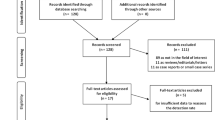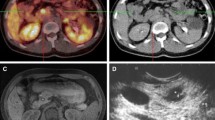Abstract
Purpose
Paraneoplastic Cushing’s syndrome (PCS) is frequently caused by neuroendocrine tumours (NETs). Approximately 20% of tumours are still occult years later. Gallium-68 somatostatin receptor-PET/CT is promising for the detection of the causal primary NET, but its role in case of recurrent PCS is rarely reported. We report our experience with DOTATOC PET/CT in localising the causal NET in cases of initial but also recurrent PCS, and its clinical impact.
Methods
A retrospective review of all DOTATOC PET/CTs performed in consecutive patients referred for PCS to our centre, between January 2011 and June 2017, was done. Nineteen patients underwent 26 PET/CTs, 13 for detection of a primary NET, seven for persistent or recurrent PCS after resection, and six for surveillance after resection of NETs previously detected on a DOTATOC PET/CT in our centre.
Results
Among the 13 PET/CTs performed to search for primary NET, five were positive: four carcinoid lung tumours were confirmed after resection and one lung focus was not confirmed since surgery would have carried a high risk. Clinical impact was 23% (3/13). Among the seven PET/CTs performed for persistent or recurrent PCS, six were true-positive, with confirmation of metastatic lymph nodes after resection. Clinical impact was 57% (4/7). All PET/CTs performed for surveillance were true-negative.
Conclusions
DOTATOC PET/CT seems to be a valuable tool for detection of the NET responsible for persistent or recurrent PCS after surgery. In this context, DOTATOC PET/CT was more effective than for the detection of the causal tumour in initial PCS.


Similar content being viewed by others

References
A. Lacroix, R.A. Feelders, C.A. Stratakis, L.K. Nieman, Cushing’s syndrome. Lancet 386(9996), 913–927 (2015)
I. Ilias, D.J. Torpy, K. Pacak, N. Mullen, R.A. Wesley, L.K. Nieman, Cushing’s Syndrome Due to Ectopic Corticotropin Secretion: Twenty Years’ Experience at the National Institutes of Health. J. Clin. Endocrinol. Metab. 90(8), 4955–4962 (2005)
J. Newell-Price, X. Bertagna, A.B. Grossman, L.K. Nieman, Cushing’s syndrome. Lancet 367(9522), 1605–1617 (2006)
A.M. Isidori, G.A. Kaltsas, C. Pozza et al. The Ectopic Adrenocorticotropin Syndrome: Clinical Features, Diagnosis, Management, and Long-Term Follow-Up. J. Clin. Endocrinol. Metab. 91(2), 371–377 (2006)
M.V. Davi’, E. Cosaro, S. Piacentini et al. Prognostic factors in ectopic Cushing’s syndrome due to neuroendocrine tumors: a multicenter study. Eur. J. Endocrinol. 176(4), 451–459 (2017)
M.S. Zemskova, B. Gundabolu, N. Sinaii, et al., Utility of various functional and anatomic imaging modalities for detection of ectopic adrenocorticotropin-secreting tumors. J. Clin. Endocrinol. Metab. 95(3), 1207–1219 (2010).
W.A.P. Breeman, M. de Jong, E. de Blois, B.F. Bernard, M. Konijnenberg, E.P. Krenning, Radiolabelling DOTA-peptides with 68Ga. Eur. J. Nucl. Med Mol. Imaging 32(4), 478–485 (2005)
A. Dutour, U. Kumar, R. Panetta, L. Ouafik, F. Fina, R. Sasi, Y.C. Patel, Expression of somatostatin receptor subtypes in human brain tumors. Int J. Cancer 76(5), 620–627 (1998)
T. Wannachalee, A.F. Turcu, I. Bancos et al. The clinical impact of [68 Ga]-DOTATATE PET/CT for the diagnosis and management of ectopic adrenocorticotropic hormone-secreting tumors. Clin Endocrinol (Oxf). 91(2), 288–294 (2019)
A. Markou, P. Manning, B. Kaya, S.N. Datta, J.B. Bomanji, G.S. Conway, [18F]fluoro-2-deoxy-D-glucose ([18F]FDG) positron emission tomography imaging of thymic carcinoid tumor presenting with recurrent Cushing’s syndrome. Eur. J. Endocrinol. Eur. Fed. Endocr. Soc. 152(4), 521–525 (2005)
C. Schalin-Jäntti, A. Ahonen, M. Seppänene, 18F-DOPA PET/CT but not 68Ga-DOTATOC PET/CT revealed the underlying cause of ectopic Cushing syndrome. Clin. Nucl. Med. 37(9), 904–905 (2012)
Z. Gözde Özkan, S. Kuyumcu, D. Balköse, B. Özkan, N. Aksakal, The Value of Somatostatin Receptor Imaging with In-111 Octreotide and/or Ga-68 DOTATATE in Localizing Ectopic ACTH Producing Tumors. Malecular Imaging Radionucl. Ther. 22(2), 49–55 (2013)
H.R. Kakade, R. Kasaliwal, V.S. Jagtap et al. Ectopic ACTH-secreting syndrome: a single-center experience. Endocr Pract Off J Am Coll Endocrinol Am Assoc. Clin. Endocrinol. 19(6), 1007–1014 (2013)
G.Z. Papadakis, U. Bagci, S.M. Sadowski, N.J. Patronas, C.A. Stratakis, Ectopic ACTH and CRH Co-secreting Tumor Localized by 68Ga-DOTA-TATE PET/CT. Clin. Nucl. Med. 40(7), 576–578 (2015)
A.S. Karageorgiadis, G.Z. Papadakis, J. Biro et al. Ectopic Adrenocorticotropic Hormone and Corticotropin-Releasing Hormone Co-Secreting Tumors in Children and Adolescents Causing Cushing Syndrome: A Diagnostic Dilemma and How to Solve It. J. Clin. Endocrinol. Metab. 100(1), 141–148 (2015)
M.J. Willhauck, G. Pöpperl, W. Rachinger, A. Giese, C.J. Auernhammer, C. Spitzweg, An unusual case of ectopic ACTH syndrome. Exp. Clin. Endocrinol. Diabetes J. Ger. Soc. Endocrinol. Ger. Diabetes Assoc. 120(2), 63–67 (2012)
R. Därr, K. Zöphel, G. Eisenhofer et al. Combined Use of 68 Ga-DOTATATE and 18 F-FDG PET/CT to Localize a Bronchial Carcinoid Associated with Ectopic ACTH Syndrome. J. Clin. Endocrinol. Metab. 97(7), 2207–2208 (2012)
L.U. Gani, E.J. Gianatti, A.S. Cheung, G. Jerums, R.J. MacIsaac, Failure of functional imaging with gallium-68-DOTA-D-Phe1-Tyr3-octreotide positron emission tomography to localize the site of ectopic adrenocorticotropic hormone secretion: a case report. J. Med Case Rep. 5(1), 405 (2011)
L. Gilardi, M. Colandrea, S.L. Fracassi, M. Sansovini, G. Paganelli, 68Ga- DOTA0-Tyr3octreotide (DOTATOC) positron emission tomography (PET)/CT in five cases of ectopic adrenocorticotropin-secreting tumours. Clin. Endocrinol. (Oxf.). 81(1), 152–153 (2014)
B. Venkitaraman, S. Karunanithi, A. Kumar, C. Bal, A.C. Ammini, R. Kumar, 68Ga-DOTATOC PET-CT in the localization of source of ectopic ACTH in patients with ectopic ACTH-dependent Cushing’s syndrome. Clin. Imaging 38(2), 208–211 (2014)
J. Singer, F. Werner, C.A. Koch et al. Ectopic Cushing’s syndrome caused by a well differentiated ACTH-secreting neuroendocrine carcinoma of the ileum. Exp. Clin. Endocrinol. Diabetes J. Ger. Soc. Endocrinol. Ger. Diabetes Assoc. 118(8), 524–529 (2010)
M.V. Davi’, M. Salgarello, G. Francia, Positive 68Ga-DOTATOC-PET/CT after cortisol level control during ketoconazole treatment in a patient with liver metastases from a pancreatic neuroendocrine tumor and ectopic Cushing syndrome. Endocrine 49(2), 566–567 (2015)
Goroshi M, Jadhav S, Lila AR, et al. Comparison of 68 Ga-DOTANOC PET/CT and CECT in localisation of tumors in EAS. Endocr Connect 5(2), 83–91 (2016). March: EC-16-0010
J.A. Veit, B. Boehm, M. Luster, A. Scheuerle, N. Rotter, G. Rettinger, M. Scheithauer, Detection of paranasal ectopic adrenocorticotropic hormone-secreting pituitary adenoma by Ga-68-DOTANOC positron-emission tomography-computed tomography. Laryngoscope 123(5), 1132–1135 (2013)
G. Treglia, E. Salomone, G. Petrone, A. Giaccari, G. Rindi, V. Rufini, A rare case of ectopic adrenocorticotropic hormone syndrome caused by a metastatic neuroendocrine tumor of the pancreas detected by 68Ga-DOTANOC and 18F-FDG PET/CT. Clin. Nucl. Med. 38(7), e306–308 (2013)
H.S. Asha, K. Sudeep, M. Alexander, A. Korula, B.R. Gnanamuthu, N. Thomas, Cushing’s syndrome in a case of thymic carcinoma. Indian J. Endocrinol. Metab. 15(4), 346–348 (2011)
S. Abubakar, Y.A. Amoako, T. Kotze, N. Tag, Source of Ectopic ACTH Secretion Easily Identified by 68 Ga DOTANOC PET/CT. Clin. Nucl. Med. 42(4), 295–296 (2017)
A.M. Isidori, E. Sbardella, M.C. Zatelli et al. Conventional and Nuclear Medicine Imaging in Ectopic Cushing’s Syndrome: A Systematic Review. J. Clin. Endocrinol. Metab. 100(9), 3231–3244 (2015)
P. Santhanam, D. Taieb, L. Giovanella, G. Treglia, PET imaging in ectopic Cushing syndrome: a systematic review. Endocrine 50(2), 297–305 (2015). https://doi.org/10.1007/s12020-015-0689-4
Acknowledgements
Dr Christina Balasa, hôpital Kremlin Bicêtre, Department of Radiology, 78 Rue du Général Leclerc, 94270 Le Kremlin-Bicêtre. Dr Camille Vatier, hôpital Saint-Antoine, Department of Endocrinology, 184 Rue du Faubourg Saint-Antoine, 75012 Paris. This work was performed in the Nuclear Medicine Department of Hôpital Tenon, Paris, France.
Author information
Authors and Affiliations
Corresponding author
Ethics declarations
Conflict of interest
The authors declare that they have no conflict of interest.
Ethical approval
All procedures performed in this study were in accordance with the ethical standards of the institutional research committee and with the 1964 Helsinki declaration and its later amendments or comparable ethical standards.
Informed consent
Informed consent was obtained from all individual participants included in the study.
Additional information
Publisher’s note Springer Nature remains neutral with regard to jurisdictional claims in published maps and institutional affiliations.
Rights and permissions
About this article
Cite this article
Bélissant Benesty, O., Nataf, V., Ohnona, J. et al. 68Ga-DOTATOC PET/CT in detecting neuroendocrine tumours responsible for initial or recurrent paraneoplastic Cushing’s syndrome. Endocrine 67, 708–717 (2020). https://doi.org/10.1007/s12020-019-02098-2
Received:
Accepted:
Published:
Issue Date:
DOI: https://doi.org/10.1007/s12020-019-02098-2



